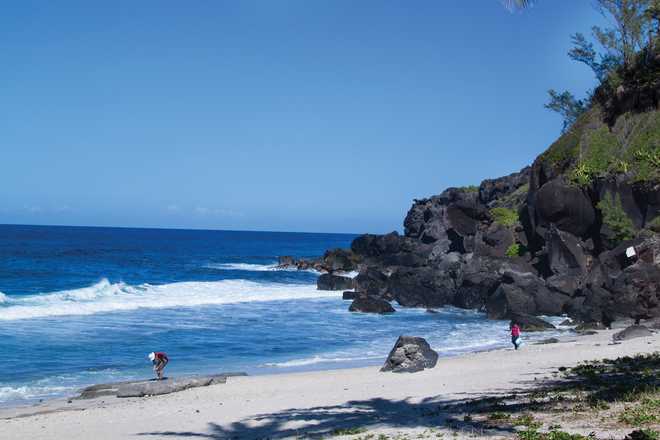
Beauty in Black: Ideal for all kinds of watersports, the black lava sea coast at the Reunion Island is quite popular.
Sudha Pillai
Reunion Island is a little-known French post in the Indian Ocean. The island was formed as a result of volcanic eruptions in the ocean bed around five million years ago. It was used as a resting spot by seafarers. In 1643, the French arrived on the island and used it as an exile for convicts. Later, they discovered that the exiled men were living it up in this tropical hideaway. That’s when the French decided to make it their tropical paradise away from the mainland.
The 2,500 km island offers a staggering variety of experiences. There are mountains to climb, and thousands of trails to hike and bike; vast stretches of beaches to comb, including black sand beaches and wild seas to indulge in some adventurous water sports or whale watching. The island is replete with lush forests, green valleys, waterfalls, rainforests and charming creole villages. The air is filled with the fragrance of sugarcane and vanilla. Above all, it still hasn’t become touristy and crowded.
As much as 42 per cent of the Reunion Island is classified as Unesco World Heritage Site. Around 30 per cent of the island has remained the same from the time of its discovery. It is truly a virgin island in more ways than one. With its 300 micro-climates, Reunion Island offers something for every traveller.
Reunion Island is also an island of volcanoes. It is home to climbable volcanoes, besides one of the most active volcanoes in the world — Piton de la Fournaise, which has erupted more than a 100 times in the past three centuries. However, it is the now dormant Piton des Neiges, a volcano that has been silent for 120 centuries, that is the pride of the island. The collapse of Piton des Neiges resulted in the creation of the three cirques or calderas in the shape of an ace of clubs — Mafate cirques in the northwest, Salazie in the northeast and Cilaos in the south.
Mafate is a mountainous landscape that can be accessed only by foot or helicopter. A chopper ride over Mafate’s million-years-old mountains and cliffs covered by a blanket of green forests and plunging waterfalls will take your breath away. And flowing through mysterious Mafate is Riviere des Galets or River of Pebbles. Cilaos is a Creole mountain village famed for fruity wines, tasty lentils and fine embroidery. It is accessible by car. But you need to traverse a winding road with 400 bends. But Cilaos with its mountain air, clear blue skies, quaint architecture and the island’s only spa is worth the effort. Salazie, which is declared a Heritage Site, is where you will find Voile de la Mariee or Bride’s Veil, one of the most beautiful vertiginous waterfalls in the island. It is also here that you will encounter Hell-Bourg, a place frozen in time, and considered one of the most beauteous villages in overseas France. It is a fine example of Creole architecture.
It is unclear how Reunion Island got its name. But it is an apt moniker for an island that is home to a potpourri of cultures — African, Creole, Indian, Chinese and European. People here speak French and very little English, but they are friendly and do not hesitate to welcome strangers into their fold. The crime rate is almost negligible in this island. Diversity is the mainstay of the place, and it can be found in the warp and weft of this island through its arts, architecture, people and cuisine.
FACTFILE
- Travel: Air Austral flies out from Chennai to Reunion Island, once a week. Flying time — six hours.
- Weather: The island has around 300 micro-climates. Carry a light, waterproof jacket. Pack for the beach, mountains and the valleys.
- Food: Rice, lentils and seafood mostly. Creole, Indian, African and Chinese cuisines. Lots of vegetarian options.
- What to do: Water sports, hiking, biking, climbing, paragliding, and so on. Creole picnic on the beaches of Trou d’Eau.
What to see
- Town of Saint-Pierre for its nightlife and Saga du Rhum Museum.
- Piton de la Fournaise or Le Volcan and the Volcano Museum.
- Wild beaches of the south — Grand Anse and Manapany.
- Lava Road in the East — you can see former lava flows here.
- Stop at Notre-Dame-des-Laves church in Sainte-Rose.
- Visit the impressive Tamil temple in Saint-Andre.
- Vanilla plantations in Sainte Suzanne.
- Creole houses and gardens of Hell-Bourgh in Salazie.
- Take a chopper ride over Mafate in the West. Walk around the market in Saint Paul. Visit the Marine Cemetery. Admire the turtles at the Kelonia Centre.
- Drive on the winding road with 400 bends to Cilaos.



























